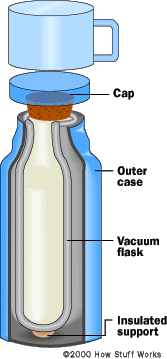The idea of conserving energy is a multifacited game of minimizing the heat transfer from someplace hot to somplace cold. how to accomplish this can be first studied by looking at the Thermos Bottle.

Heat Losses in a Building.
Thermal Insulation Chapter 5
20% of energy consumed in the U.S. is used for space
heating.
Recall the
Cathedral in Bath England
Effect of Thermal Insulation. Limit
Conductive Heat Losses
Q/t = [kA(T2-T1)]/L
- Q/t = Heat Loss (or Gain during Summer)
- K = Conductivity
- A = Surface Area
- (T2-T1) = Temperature Difference between
inside and outside
- L= thickness of material.
Low e Windows: Home Energy Magazine Online
Energy Conservation Basics Energy Conservation: Heating and Insulation
Insulation Information Click on Energy, then insulation. Also click on information regarding energy issues. For example, what is a ZEH?
Degree Days
Degree Days Article (U.S.News)
- Unit Degree Day (650F - Average Outside Temperature) Each Day
R-value
R=L/k The thickness of the material divided by
its conductivity.
R values for a wall made up of different materials
add together.
RT=R1+R2+R3+...
Q=(A*(T2-T1)*t)/RT
For heat needs in an entire season
Q=(A*(Number of Annual Degree Days)*(24Hours/Day))/RT
Air Infiltration ( Seal The Air
Leaks)
- Caulking
- Automatic Closing of the furnace
flue
- Glass fireplace doors
- Health effects
- Increased Carbon Dioxide and Carbon
Monoxide
- Radon Gas
Water Heaters
- Use 10% to 20% of the energy in a typical
home.
- Water Has A high specific heat, therefore
it takes allot of energy to raise its temperature.
- Save Energy by:
- Lowering Temperature
- Insulating exterior and hot water
pipes
- Reduce usage: Water saving devices (Front Loading Washers: High Spin Rates)
- Electric Igniters (no pilot light)
- Flue damper
Clothes dryer can use 15% of the electrical
energy in a house
- Use Outside or indoors drying
methods
- Use a gas dryer
Food Prep : Stove
- Small well insulated ovens are move
efficient
- Waste heat goes into the house in the
winter, adds to heating. Bake your own bread in the
Winter
Lighting
- 5% of the Total energy Usage goes to
Lighting
- Change to energy efficient Fluorescent
Bulbs
- Design for maximum light for
daytime
The Energy Conserving House
- California Example: A $2700 investment
reduced usage by a factor of 3.
- In Oregon EWEB: Energy Buy Back Program:
Pay for Insulation upgrades to older homes.
Payback Periods:
Invest in energy conservation and save energy. Payback comes from the money saved by not using as much energy. Payback Times can be relatively short and can be made faster with rebate incentives form governments and local utilities.
For example, insulating a house or buying an energy saving appliance can sot you hundreds of dollars, but the paybeack time can be just a few years and then after those years, you are saving money and energy by consuming less energy.
Homework questions illustrates this.

